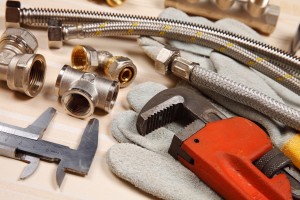 There are some plumbing jobs that require attention from the pros. Broken pipes or a clogged sewer line are reasons to call a licensed plumber. But if you’re confident you can handle some smaller jobs, it’s best to be properly equipped. Having the right tools on hand can make a repair much simpler. The most common plumbing tools can handle several different tasks.
There are some plumbing jobs that require attention from the pros. Broken pipes or a clogged sewer line are reasons to call a licensed plumber. But if you’re confident you can handle some smaller jobs, it’s best to be properly equipped. Having the right tools on hand can make a repair much simpler. The most common plumbing tools can handle several different tasks.
Load your toolbox with these plumbing tools:
- Adjustable wrench: One of the most versatile tools you should own is an adjustable wrench. It can fit a number of hardware sizes and is fairly inexpensive. It’s good to have a few of these on hand – especially in different sizes. They’ll make small jobs, like replacing fixtures, more simple.
- Basin wrench: The name of this tool can be misleading. Unlike other styles of wrenches, the basin wrench uses a clamping mechanism to grab bolts in tight spaces. It’s handy for loosening nuts in hard-to-reach areas, like under the bathroom sink.
- Jointing compound: Often called plumber’s putty, this item helps create a seal around joints. The putty can be applied to connecting pipes of drains or faucets to prevent leaks.
- Pipe wrench: These tools are better kept in pairs. You’ll often need one to stabilize your work and the other to adjust a bolt or nut. These tools are perfect for larger jobs that require gaining leverage, like loosening a stuck fitting.
- Teflontape: If a threaded joint is leaking, Teflon tape, or thread seal tape, can create a strong seal. Wrap 3-4 layers of the tape around clean, dry thread. Once you screw the pieces back together, the tape will form a waterproof seal.
- Plunger: You likely already have this tool in your house, and for good reason. A plunger is handy for a number of different clogs. Whether it’s the toilet, kitchen sink or bathtub, a few vigorous plunges should shake up a small clog and allow your water to flow freely again. If the plunger keeps slipping or it’s difficult to get a tight seal before plunging, put a thin layer of petroleum jellyaround the edges to help create a seal.
- Toilet auger: Often called a plumbing snake, the auger can be used to fish out hair, debris and other types of clogs that the plunger can’t handle.
- Tongue and groove pliers: Firmly hold things in place with a pair of tongue and groove pliers. These pliers can loosen, tighten or turn different hardware. The serrated clamps give them good holding power for tougher jobs.
Even if you don’t consider yourself a big DIY project person, these basic plumbing tools can be used for a variety of tasks and help prevent a major plumbing emergency. Use the tools to repair your basic plumbing problems and call in a professional plumber for the larger jobs.
